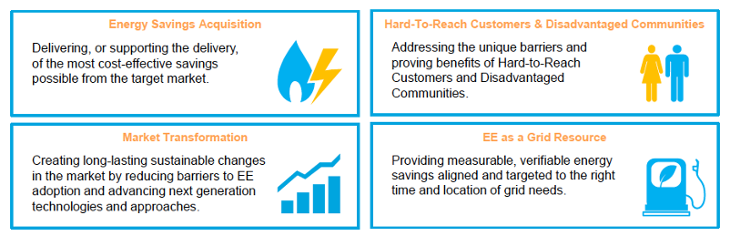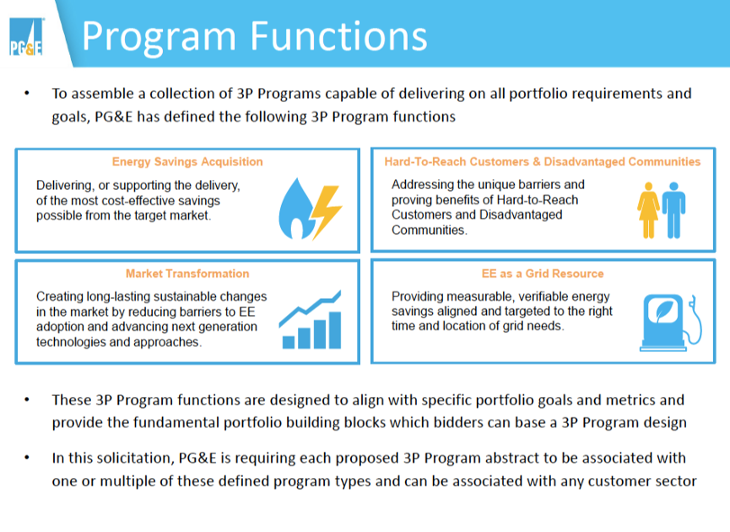
This is a guest post by Matt Golden, CEO of AEE member company OpenEE.
Energy efficiency in California is rapidly evolving. Moving toward the state’s 50% renewable portfolio standard (RPS), SB350 goals to double energy efficiency and renewable energy, and perhaps most importantly, new SB100 requirements to achieve zero carbon on the grid by 2045, it has become necessary to rethink our demand-side strategy. Achieving these lofty targets while maintaining a balanced, stable, and affordable grid will take all the distributed energy resources we can get, including a massive increase in demand flexibility from energy efficiency, electrification, and controls.
New solicitations for energy efficiency services from California’s investor-owned utilities point the way toward a future of performance-based capture of energy savings when and where they matter, driven by innovation in the marketplace. Energy efficiency providers should see this as an opportunity – and there’s no time to waste.
In order to deliver the innovation and investment required to scale beyond current ratepayer programs, and to deliver savings when and where they are most valuable to the grid and policy goals, California is rethinking how energy efficiency is valued and delivered. Leveraging investments in smart metering infrastructure, the state is now taking advantage of more precise data and measurement to move rapidly away from technology-specific programs toward markets that pay for the aggregated change in consumption at the meter, taking into account time and location of the impact.
Investor-owned utilities (IOU) in California are taking the initiative by rethinking how they capture demand-side resources in the new mandates for carbon-driven integrated resource planning. In November, this shift was clearly articulated in joint comments by the California IOUs to the California Public Utilities Commission:
“The advent of Pay-for-Performance programs, the growth of on-bill financing offerings, market transformation initiatives, load shifting, and integrated DR strategies, among other new strategies, are all expected to play central roles in the upcoming EE portfolios, while the traditional measure-based deemed and custom interventions that serve as the foundation for the current EE Potential and Goals modeling are becoming less prevalent.”
This is more than words. All four California IOUs recently released requests for abstracts from market participants to bring forward their best and brightest ideas to make the transition to performance-based procurement through third-party programs, the first step in a CPUC requirement to move 60% of the State’s utility run efficiency programs to third party providers.
Of the four California IOUs, Pacific Gas & Electric (PG&E) stands out for the forward-looking vision articulated in its solicitation. PG&E tackles the Commission’s directive to leverage market actors in deploying cost-effective energy efficiency with a focus on preparing the market for a future where demand flexibility, including energy efficiency, can be ready to serve the grid more effectively.
“The California grid and the role of energy efficiency in it are changing,” says Matthew Braunwarth, Manager of Energy Efficiency Program Procurement at PG&E. “We need new and innovative solutions that will drive substantial increases in consumer demand through innovative technology and business models. We also need solutions that are delivered when and where they are most valuable as a load shaping resource to enable the continued growth of renewables and to support non-wires alternatives to grid infrastructure as we decarbonize our grid.”
PG&E is also expanding its innovative pay-for-performance programs, in alignment with the Commission’s stated preference for performance-based programs that leverage meter-based quantification, by asking bidders to “describe the extent which the 3P [third party] will adopt performance payment contracting terms.”
In an attempt to deliver on all portfolio requirements and goals and set a trajectory for a grid-integrated future, PG&E has requested that third parties focus on achieving one or more of the following four objectives, pulled directly from the PG&E solicitation:

Perhaps the most exciting element of these new third-party programs is the preference for grid resource “programs that utilize AMI customer data to support near real-time [measurement and verification] (“M&V 2.0”)...[that] deliver verified energy savings and/or capacity that can be substantiated to a specific time and geographic location.” Here how it's described by PG&E:

Combining pay-for-performance with time and locational meter-based savings represents a major leap forward for energy efficiency, enabling it to compete as a true distributed energy resource.
“Our focus in this process is the customer and how do we put the highest quality programs at their fingertips,” says Braunwarth. PG&E's RFA is designed to invite innovation and broaden the pool of potential applicants by minimizing the barriers of entry to submit new program ideas that deliver value for building owners and the electric power system.
The process starts with a 12-page conceptual document that summarizes business models and approaches. “We hope to see a diverse set of ideas from existing and new players and recognize the barrier traditional RFPs can present,” explains Braunwarth. “PG&E’s solicitation process is intended to work more like college admissions, building a well-rounded cohort of promising program ideas that will advance to subsequent stages in the process for further analysis. We will work with those bidders to facilitate a final compliant proposal that works for the market and delivers value to PG&E and our customers.”
The PG&E Request for Abstract (RFA) is out right now, with responses due January 14th. SCE, SoCalGas, and SDG&E all have their own solicitations on the street. Given the intentional simplicity of the RFA as a first step in the process, there is still plenty of time respond – but no time to waste!
If you want to learn more about embedding M&V 2.0, pay-for-performance, and time and locational energy efficiency into your business models and proposals, OpenEE can help. Feel free to contact us.
AEE has published a set of seven issue briefs on key topics in utility regulation in a changing electric power system: advanced metering, access to data, optimizing capital and service expenditures, energy efficiency as a resource, performance-based regulation, rate design for a DER future, and distribution system planning.
